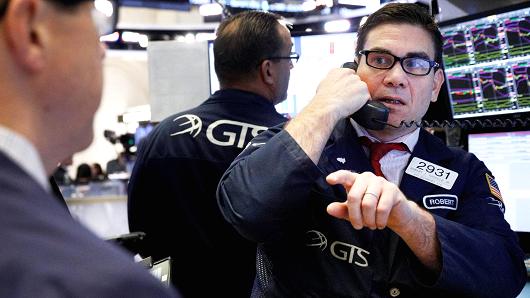
Stocks had a jumpy start to February and could be at an inflection point, depending in part on the direction of interest rates.
Both Apple and Amazon were higher after the bell Thursday, and that post-earnings strength could spill into Friday’s trading. Friday could also be affected by the jobs report, expected to show 180,000 jobs added in January and an unemployment rate of 4.1 percent.
In the bond market, traders are watching to see if the wage number in that employment report rises more than the 0.3 percent expected, which they would take as an inflationary sign.
Bond yields have been spooking stocks. They’ve been zipping higher on rising inflation expectations, and if actual data shows inflation picking up, the concern is the Fed and other central banks will raise interest rates and tighten more than expected this year.
The benchmark 10-year Treasury yield, which affects mortgages and other loans, was at a fresh four-year high of 2.79 percent Thursday, rising from 2.66 percent at the end of last week. It was at just 2.40 at the start of the year.
“The strength in Apple and Amazon could set up for a push-pull” against rising rates, said Scott Redler, partner with T3Live.com. Alphabet also reported earnings Thursday afternoon, but shares of Google’s parent were lower in after hours trading.
Redler and other technical analysts say it’s unclear whether the market will stay in a correction phase. But to some, the recent volatility suggests there could be a pullback that could take stocks several percent lower before dip buyers step in.
The choppiness of the past several days has been an unusual divergence for a market that hasn’t had a 3 percent pullback since the days before the presidential election in November 2016. The worst sell-off before that was the 5.3 percent decline after Britain voted to leave the European Union in June 2016.
Stocks were rocky Thursday; the S&P 500 was down just 1 point at 2,821, but it has lost 1.8 percent this week.
The S&P 500 broke below 2,840, its 8-day moving average, this week, which traders watch for strength of momentum.
“If you stay below the 8-day and not reclaim it, that shows continued weakness, and it gives the bears a little confidence that there are lower prices coming,” said Redler, who said he’s watching 2,810 as a possible floor. “The more we stay below 2,840, the higher the probability that the corrective phase could last longer. The composure of the market feels like it changed.”
Paul LaRosa, chief technician at Maxim Group, is watching 26,000 on the Dow, which closed at 26,186. If it breaks that level, he says, there could be a drop of 1,000 points. The Dow closed 37 points higher at 26,186 Thursday.
“We’re definitely at more risk in the last three days. We’re seeing wild fluctuations, volatility. … If you look at the 10-year interest rates, it looks like they’re going higher. Then we’re getting concerns of inflation, gold is strengthening up. … I think what you’re seeing is overall interest rate concerns.” LaRosa said the 10-year chart looks like yields could move as high as 3.25 percent by year end.
Fundstrat Global Advisors technical analyst Robert Sluymer said if the market continues to decline, the S&P could go close to 2,700. “A pullback to the 50-day [moving average] is 2,711 … we don’t know for sure if it’s pulling back, but that’s not an unusual level for it to pull back to … that’s just under 4 percent,” he said.
He said a 5 to 8 percent correction would not be at all surprising.
“What we’re seeing is not cataclysmic and not the end of the bull market,” he said. Sluymer said he’s been watching reversals in cyclicals, such as industrials, that had been overextended. He said utilities could have just a short-lived bounce.
“I think areas like biotech are pretty interesting, and they look like they’re emerging,” he said.
But one thing that could determine where stocks go is how they react to interest rates. Some strategists say interest rates could be reaching a near-term top, but the trade has been driven by momentum, and it’s hard to tell.
Redler said the stock market is reacting to each level higher in rates, and it’s possible that 3 percent yield on the 10-year could be a real danger zone for equities. Bond prices move opposite to yield.
“I’m calling it the financial game of chicken. Who moves first? If the bond market keeps moving like this, the stock market cannot ignore it,” said Nomura fixed-income strategist George Goncalves. “If it keeps nudging rates, ultimately there’s going to be a competition between stocks and bonds. Among the things that could stop this sell-off [in bonds] are either an equity market correction or value investors come in and the [Treasury] auctions are good next week.”
The Treasury announced new bigger sizes for Treasury auctions when it announced refunding needs Thursday, and that added to bond-market jitters.
